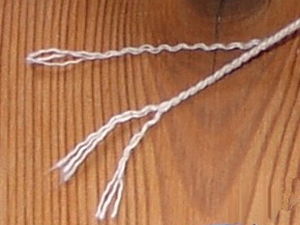Twine
Natural fibres used for making twine include wool, cotton, sisal, jute, hemp, henequen, paper, and coir.
[2] Indeed, Elizabeth Wayland Barber has called the development of twine, which can be made far stronger and longer than its component fibers, "the string revolution.
"[2] Twine could be used to fasten points and blades to arrows, spears, harpoons and other tools and to make snares, bags, baby slings, fishing and hunting nets and marine tackle, not to mention to secure firewood, haul goods and anchor tents and shelters.
However, unlike stone or metal tools, most twine is missing from the archaeological record because it is made of perishable materials that rarely survive over time.
[4] In fact, the discovery of ancient beads and the dating of sea travel to at least 60,000 years ago suggests that the "string revolution" might have occurred much earlier than the Upper Paleolithic.
[10] In 2016, a carved piece of mammoth ivory with three holes, dated at 40,000 years old, was unearthed at the Hohle Fels site, famous for the discovery of both Paleolithic female figurines and flutes.
[12] A small piece of cord discovered at Abris du Muras, in south-eastern France, has been dated to around 50,000 years ago.
[17] Imprints of woven material in clay found at Dolni Vestonice I and several other sites in Moravia date to 26,000 years ago.
[18] and were found along with needles and tools that were used to sew clothing and make nets for hunting small animals and birds.
[19] Beads, as well as shells and animal teeth with man-made holes, have also been used as indirect evidence of twining, as have net sinkers and tools with the marks of cord wear.


